Management and Operations at Uber: Roles, Approaches, and Factors
VerifiedAdded on 2023/01/04
|12
|3700
|51
Report
AI Summary
This report provides a comprehensive analysis of leadership and management roles within Uber, examining the distinctions between leaders and managers, and how they function in various scenarios. It explores the application of different leadership approaches and theories, such as situational leadership, and assesses their strengths and weaknesses. Furthermore, the report delves into key approaches to operations management, including total quality management (TQM), just-in-time (JIT) inventory management, and the Six Sigma approach, highlighting the roles of leaders and managers in each. The importance of operations management in achieving business objectives is justified, and factors within the business environment that impact operational decision-making are discussed, providing a holistic view of Uber's management and operational strategies.

Management and Operations
1
1
Paraphrase This Document
Need a fresh take? Get an instant paraphrase of this document with our AI Paraphraser
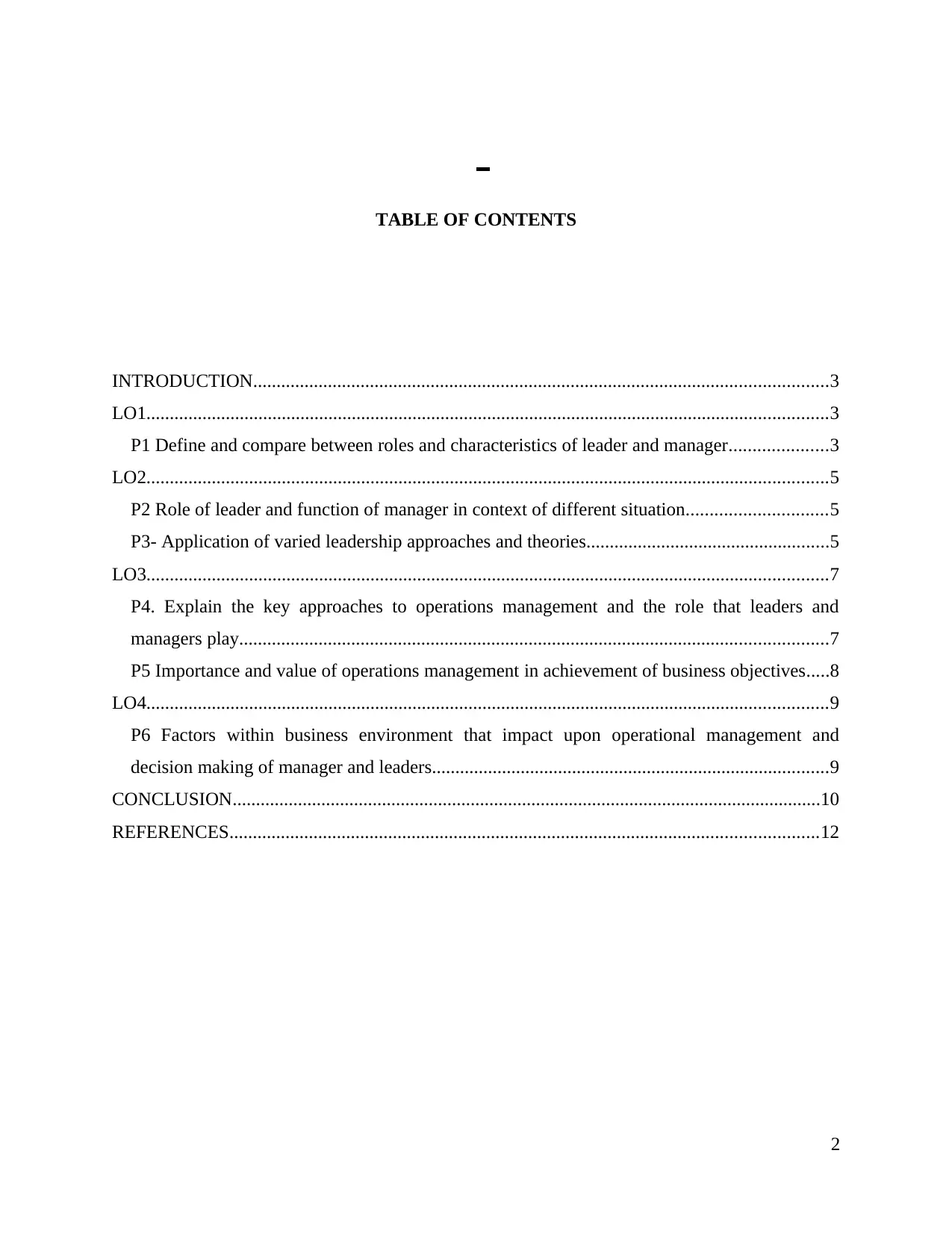
TABLE OF CONTENTS
INTRODUCTION...........................................................................................................................3
LO1..................................................................................................................................................3
P1 Define and compare between roles and characteristics of leader and manager.....................3
LO2..................................................................................................................................................5
P2 Role of leader and function of manager in context of different situation..............................5
P3- Application of varied leadership approaches and theories....................................................5
LO3..................................................................................................................................................7
P4. Explain the key approaches to operations management and the role that leaders and
managers play..............................................................................................................................7
P5 Importance and value of operations management in achievement of business objectives.....8
LO4..................................................................................................................................................9
P6 Factors within business environment that impact upon operational management and
decision making of manager and leaders.....................................................................................9
CONCLUSION..............................................................................................................................10
REFERENCES..............................................................................................................................12
2
INTRODUCTION...........................................................................................................................3
LO1..................................................................................................................................................3
P1 Define and compare between roles and characteristics of leader and manager.....................3
LO2..................................................................................................................................................5
P2 Role of leader and function of manager in context of different situation..............................5
P3- Application of varied leadership approaches and theories....................................................5
LO3..................................................................................................................................................7
P4. Explain the key approaches to operations management and the role that leaders and
managers play..............................................................................................................................7
P5 Importance and value of operations management in achievement of business objectives.....8
LO4..................................................................................................................................................9
P6 Factors within business environment that impact upon operational management and
decision making of manager and leaders.....................................................................................9
CONCLUSION..............................................................................................................................10
REFERENCES..............................................................................................................................12
2
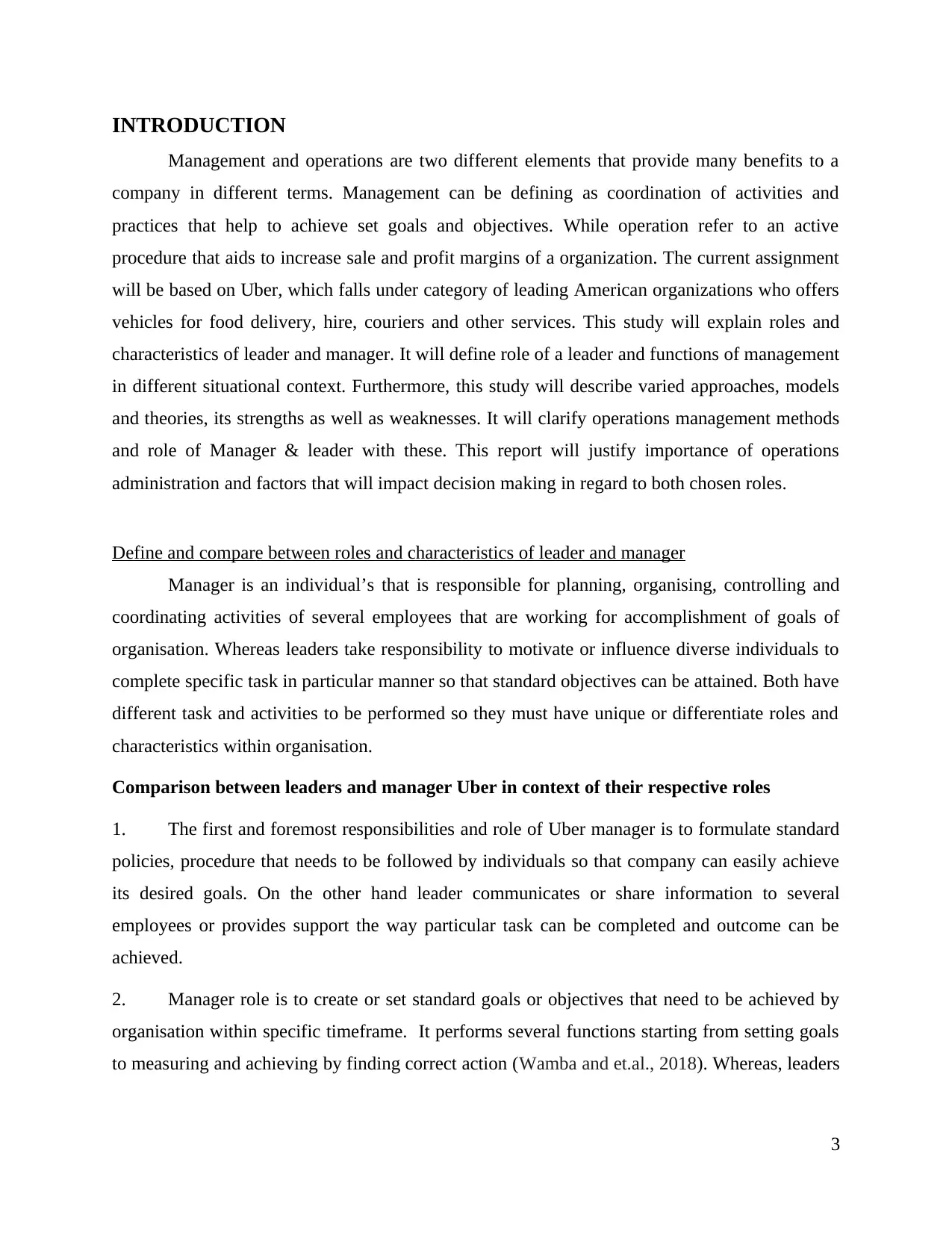
INTRODUCTION
Management and operations are two different elements that provide many benefits to a
company in different terms. Management can be defining as coordination of activities and
practices that help to achieve set goals and objectives. While operation refer to an active
procedure that aids to increase sale and profit margins of a organization. The current assignment
will be based on Uber, which falls under category of leading American organizations who offers
vehicles for food delivery, hire, couriers and other services. This study will explain roles and
characteristics of leader and manager. It will define role of a leader and functions of management
in different situational context. Furthermore, this study will describe varied approaches, models
and theories, its strengths as well as weaknesses. It will clarify operations management methods
and role of Manager & leader with these. This report will justify importance of operations
administration and factors that will impact decision making in regard to both chosen roles.
Define and compare between roles and characteristics of leader and manager
Manager is an individual’s that is responsible for planning, organising, controlling and
coordinating activities of several employees that are working for accomplishment of goals of
organisation. Whereas leaders take responsibility to motivate or influence diverse individuals to
complete specific task in particular manner so that standard objectives can be attained. Both have
different task and activities to be performed so they must have unique or differentiate roles and
characteristics within organisation.
Comparison between leaders and manager Uber in context of their respective roles
1. The first and foremost responsibilities and role of Uber manager is to formulate standard
policies, procedure that needs to be followed by individuals so that company can easily achieve
its desired goals. On the other hand leader communicates or share information to several
employees or provides support the way particular task can be completed and outcome can be
achieved.
2. Manager role is to create or set standard goals or objectives that need to be achieved by
organisation within specific timeframe. It performs several functions starting from setting goals
to measuring and achieving by finding correct action (Wamba and et.al., 2018). Whereas, leaders
3
Management and operations are two different elements that provide many benefits to a
company in different terms. Management can be defining as coordination of activities and
practices that help to achieve set goals and objectives. While operation refer to an active
procedure that aids to increase sale and profit margins of a organization. The current assignment
will be based on Uber, which falls under category of leading American organizations who offers
vehicles for food delivery, hire, couriers and other services. This study will explain roles and
characteristics of leader and manager. It will define role of a leader and functions of management
in different situational context. Furthermore, this study will describe varied approaches, models
and theories, its strengths as well as weaknesses. It will clarify operations management methods
and role of Manager & leader with these. This report will justify importance of operations
administration and factors that will impact decision making in regard to both chosen roles.
Define and compare between roles and characteristics of leader and manager
Manager is an individual’s that is responsible for planning, organising, controlling and
coordinating activities of several employees that are working for accomplishment of goals of
organisation. Whereas leaders take responsibility to motivate or influence diverse individuals to
complete specific task in particular manner so that standard objectives can be attained. Both have
different task and activities to be performed so they must have unique or differentiate roles and
characteristics within organisation.
Comparison between leaders and manager Uber in context of their respective roles
1. The first and foremost responsibilities and role of Uber manager is to formulate standard
policies, procedure that needs to be followed by individuals so that company can easily achieve
its desired goals. On the other hand leader communicates or share information to several
employees or provides support the way particular task can be completed and outcome can be
achieved.
2. Manager role is to create or set standard goals or objectives that need to be achieved by
organisation within specific timeframe. It performs several functions starting from setting goals
to measuring and achieving by finding correct action (Wamba and et.al., 2018). Whereas, leaders
3
⊘ This is a preview!⊘
Do you want full access?
Subscribe today to unlock all pages.

Trusted by 1+ million students worldwide
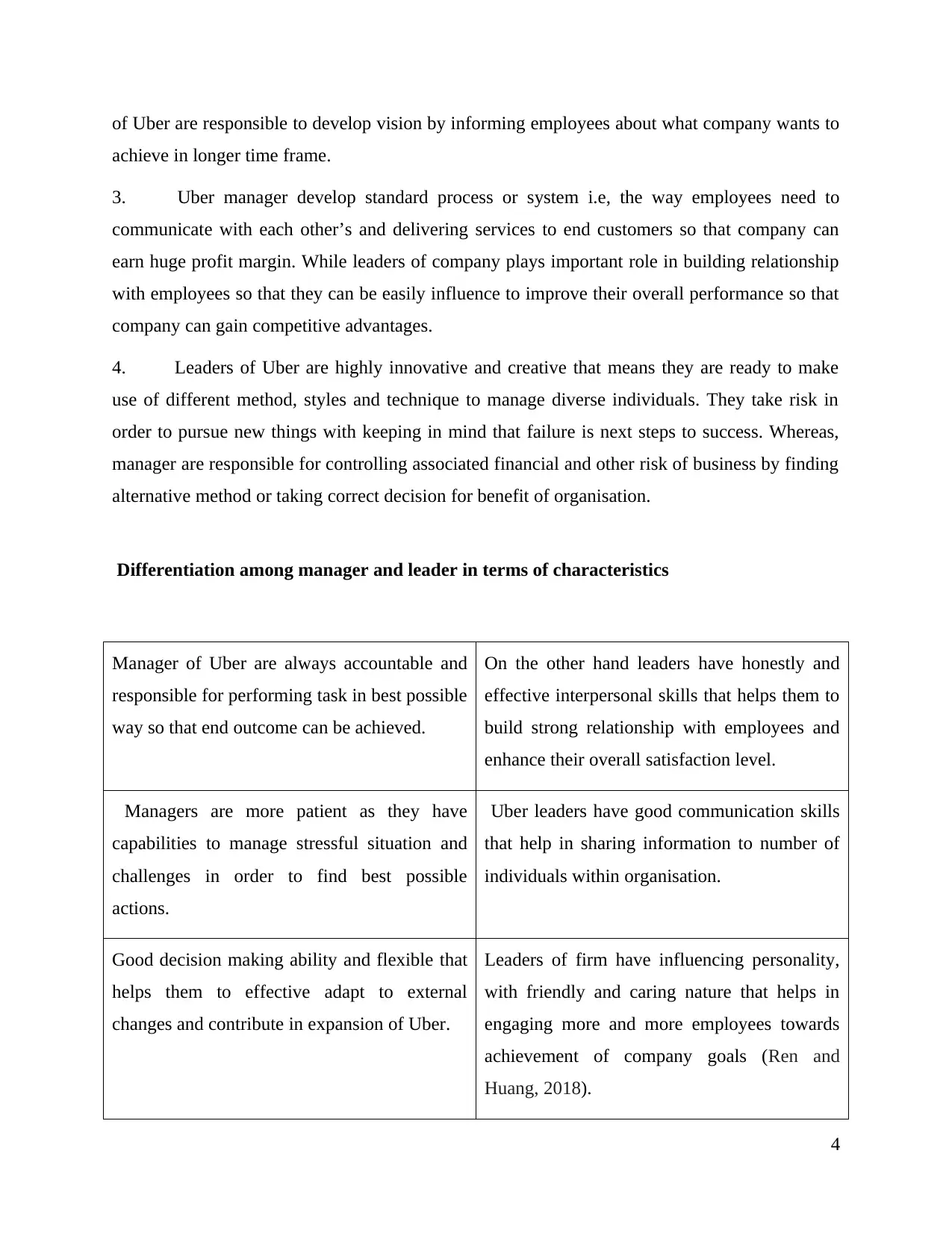
of Uber are responsible to develop vision by informing employees about what company wants to
achieve in longer time frame.
3. Uber manager develop standard process or system i.e, the way employees need to
communicate with each other’s and delivering services to end customers so that company can
earn huge profit margin. While leaders of company plays important role in building relationship
with employees so that they can be easily influence to improve their overall performance so that
company can gain competitive advantages.
4. Leaders of Uber are highly innovative and creative that means they are ready to make
use of different method, styles and technique to manage diverse individuals. They take risk in
order to pursue new things with keeping in mind that failure is next steps to success. Whereas,
manager are responsible for controlling associated financial and other risk of business by finding
alternative method or taking correct decision for benefit of organisation.
Differentiation among manager and leader in terms of characteristics
Manager of Uber are always accountable and
responsible for performing task in best possible
way so that end outcome can be achieved.
On the other hand leaders have honestly and
effective interpersonal skills that helps them to
build strong relationship with employees and
enhance their overall satisfaction level.
Managers are more patient as they have
capabilities to manage stressful situation and
challenges in order to find best possible
actions.
Uber leaders have good communication skills
that help in sharing information to number of
individuals within organisation.
Good decision making ability and flexible that
helps them to effective adapt to external
changes and contribute in expansion of Uber.
Leaders of firm have influencing personality,
with friendly and caring nature that helps in
engaging more and more employees towards
achievement of company goals (Ren and
Huang, 2018).
4
achieve in longer time frame.
3. Uber manager develop standard process or system i.e, the way employees need to
communicate with each other’s and delivering services to end customers so that company can
earn huge profit margin. While leaders of company plays important role in building relationship
with employees so that they can be easily influence to improve their overall performance so that
company can gain competitive advantages.
4. Leaders of Uber are highly innovative and creative that means they are ready to make
use of different method, styles and technique to manage diverse individuals. They take risk in
order to pursue new things with keeping in mind that failure is next steps to success. Whereas,
manager are responsible for controlling associated financial and other risk of business by finding
alternative method or taking correct decision for benefit of organisation.
Differentiation among manager and leader in terms of characteristics
Manager of Uber are always accountable and
responsible for performing task in best possible
way so that end outcome can be achieved.
On the other hand leaders have honestly and
effective interpersonal skills that helps them to
build strong relationship with employees and
enhance their overall satisfaction level.
Managers are more patient as they have
capabilities to manage stressful situation and
challenges in order to find best possible
actions.
Uber leaders have good communication skills
that help in sharing information to number of
individuals within organisation.
Good decision making ability and flexible that
helps them to effective adapt to external
changes and contribute in expansion of Uber.
Leaders of firm have influencing personality,
with friendly and caring nature that helps in
engaging more and more employees towards
achievement of company goals (Ren and
Huang, 2018).
4
Paraphrase This Document
Need a fresh take? Get an instant paraphrase of this document with our AI Paraphraser
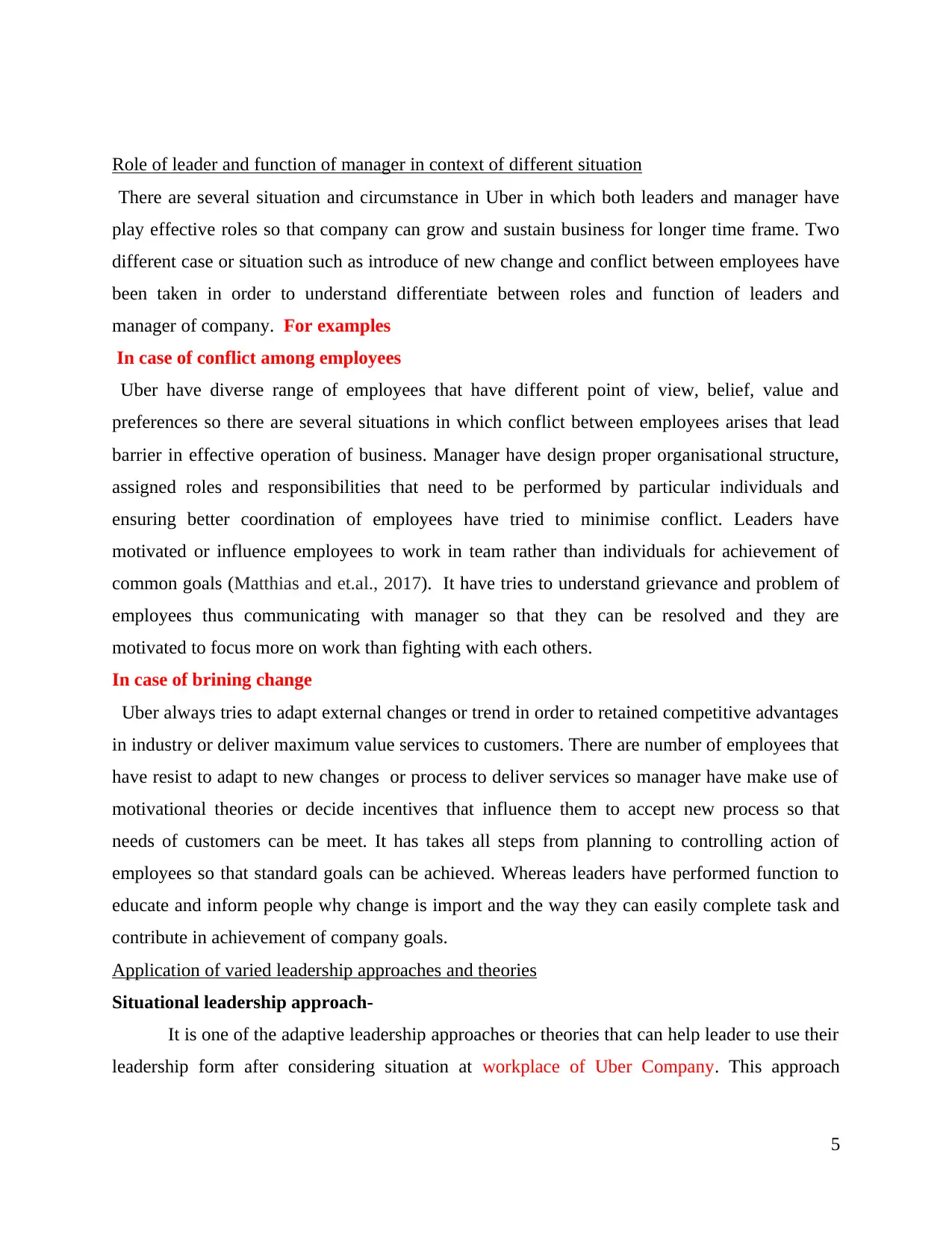
Role of leader and function of manager in context of different situation
There are several situation and circumstance in Uber in which both leaders and manager have
play effective roles so that company can grow and sustain business for longer time frame. Two
different case or situation such as introduce of new change and conflict between employees have
been taken in order to understand differentiate between roles and function of leaders and
manager of company. For examples
In case of conflict among employees
Uber have diverse range of employees that have different point of view, belief, value and
preferences so there are several situations in which conflict between employees arises that lead
barrier in effective operation of business. Manager have design proper organisational structure,
assigned roles and responsibilities that need to be performed by particular individuals and
ensuring better coordination of employees have tried to minimise conflict. Leaders have
motivated or influence employees to work in team rather than individuals for achievement of
common goals (Matthias and et.al., 2017). It have tries to understand grievance and problem of
employees thus communicating with manager so that they can be resolved and they are
motivated to focus more on work than fighting with each others.
In case of brining change
Uber always tries to adapt external changes or trend in order to retained competitive advantages
in industry or deliver maximum value services to customers. There are number of employees that
have resist to adapt to new changes or process to deliver services so manager have make use of
motivational theories or decide incentives that influence them to accept new process so that
needs of customers can be meet. It has takes all steps from planning to controlling action of
employees so that standard goals can be achieved. Whereas leaders have performed function to
educate and inform people why change is import and the way they can easily complete task and
contribute in achievement of company goals.
Application of varied leadership approaches and theories
Situational leadership approach-
It is one of the adaptive leadership approaches or theories that can help leader to use their
leadership form after considering situation at workplace of Uber Company. This approach
5
There are several situation and circumstance in Uber in which both leaders and manager have
play effective roles so that company can grow and sustain business for longer time frame. Two
different case or situation such as introduce of new change and conflict between employees have
been taken in order to understand differentiate between roles and function of leaders and
manager of company. For examples
In case of conflict among employees
Uber have diverse range of employees that have different point of view, belief, value and
preferences so there are several situations in which conflict between employees arises that lead
barrier in effective operation of business. Manager have design proper organisational structure,
assigned roles and responsibilities that need to be performed by particular individuals and
ensuring better coordination of employees have tried to minimise conflict. Leaders have
motivated or influence employees to work in team rather than individuals for achievement of
common goals (Matthias and et.al., 2017). It have tries to understand grievance and problem of
employees thus communicating with manager so that they can be resolved and they are
motivated to focus more on work than fighting with each others.
In case of brining change
Uber always tries to adapt external changes or trend in order to retained competitive advantages
in industry or deliver maximum value services to customers. There are number of employees that
have resist to adapt to new changes or process to deliver services so manager have make use of
motivational theories or decide incentives that influence them to accept new process so that
needs of customers can be meet. It has takes all steps from planning to controlling action of
employees so that standard goals can be achieved. Whereas leaders have performed function to
educate and inform people why change is import and the way they can easily complete task and
contribute in achievement of company goals.
Application of varied leadership approaches and theories
Situational leadership approach-
It is one of the adaptive leadership approaches or theories that can help leader to use their
leadership form after considering situation at workplace of Uber Company. This approach
5
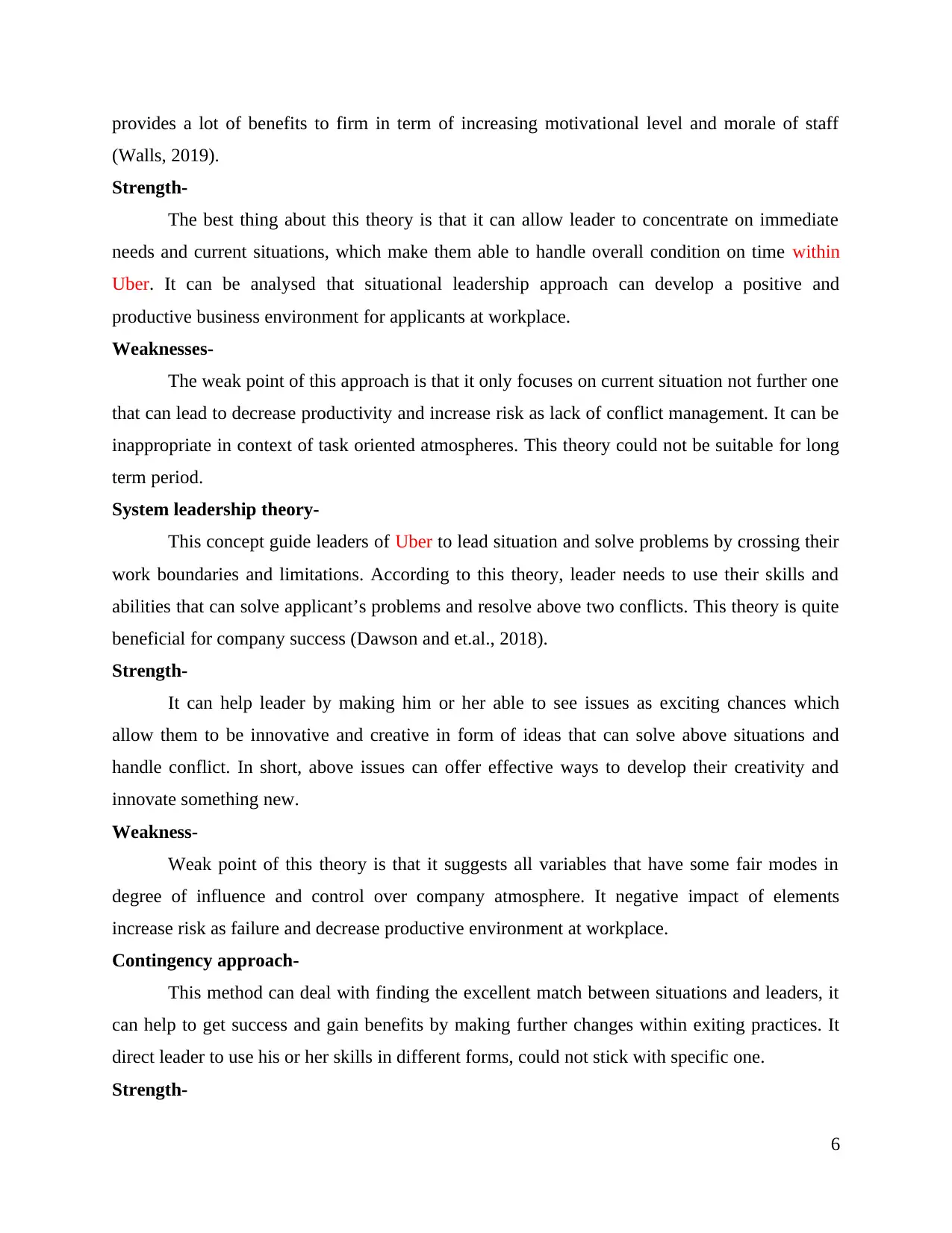
provides a lot of benefits to firm in term of increasing motivational level and morale of staff
(Walls, 2019).
Strength-
The best thing about this theory is that it can allow leader to concentrate on immediate
needs and current situations, which make them able to handle overall condition on time within
Uber. It can be analysed that situational leadership approach can develop a positive and
productive business environment for applicants at workplace.
Weaknesses-
The weak point of this approach is that it only focuses on current situation not further one
that can lead to decrease productivity and increase risk as lack of conflict management. It can be
inappropriate in context of task oriented atmospheres. This theory could not be suitable for long
term period.
System leadership theory-
This concept guide leaders of Uber to lead situation and solve problems by crossing their
work boundaries and limitations. According to this theory, leader needs to use their skills and
abilities that can solve applicant’s problems and resolve above two conflicts. This theory is quite
beneficial for company success (Dawson and et.al., 2018).
Strength-
It can help leader by making him or her able to see issues as exciting chances which
allow them to be innovative and creative in form of ideas that can solve above situations and
handle conflict. In short, above issues can offer effective ways to develop their creativity and
innovate something new.
Weakness-
Weak point of this theory is that it suggests all variables that have some fair modes in
degree of influence and control over company atmosphere. It negative impact of elements
increase risk as failure and decrease productive environment at workplace.
Contingency approach-
This method can deal with finding the excellent match between situations and leaders, it
can help to get success and gain benefits by making further changes within exiting practices. It
direct leader to use his or her skills in different forms, could not stick with specific one.
Strength-
6
(Walls, 2019).
Strength-
The best thing about this theory is that it can allow leader to concentrate on immediate
needs and current situations, which make them able to handle overall condition on time within
Uber. It can be analysed that situational leadership approach can develop a positive and
productive business environment for applicants at workplace.
Weaknesses-
The weak point of this approach is that it only focuses on current situation not further one
that can lead to decrease productivity and increase risk as lack of conflict management. It can be
inappropriate in context of task oriented atmospheres. This theory could not be suitable for long
term period.
System leadership theory-
This concept guide leaders of Uber to lead situation and solve problems by crossing their
work boundaries and limitations. According to this theory, leader needs to use their skills and
abilities that can solve applicant’s problems and resolve above two conflicts. This theory is quite
beneficial for company success (Dawson and et.al., 2018).
Strength-
It can help leader by making him or her able to see issues as exciting chances which
allow them to be innovative and creative in form of ideas that can solve above situations and
handle conflict. In short, above issues can offer effective ways to develop their creativity and
innovate something new.
Weakness-
Weak point of this theory is that it suggests all variables that have some fair modes in
degree of influence and control over company atmosphere. It negative impact of elements
increase risk as failure and decrease productive environment at workplace.
Contingency approach-
This method can deal with finding the excellent match between situations and leaders, it
can help to get success and gain benefits by making further changes within exiting practices. It
direct leader to use his or her skills in different forms, could not stick with specific one.
Strength-
6
⊘ This is a preview!⊘
Do you want full access?
Subscribe today to unlock all pages.

Trusted by 1+ million students worldwide

It is adaptive and this strength makes it unique more than other leadership approaches.
With this approach, management and leaders can recognize overall factors, examine and analyse
situations in effective manner that lead to conflict resolution.
Weakness-
This method is complex and difficult to implement because it allow leader to use range of
leadership styles, skills and capabilities which is not possible and require in each situation as it
consume time and efforts as well. The suggestions of this theory is easy to understand and
difficult to include in practical activities.
LO3
P4. Explain the key approaches to operations management and the role that leaders and managers
play.
There are various approaches to operations management which can be used by Uber in order to
enhance their productivity and also operational efficiency. Key approaches includes the
following:
Total quality management: This can be adopted by Uber. It is an approach which can be
used for long term consumer satisfaction. In this company can be engaged in improving their
process so that quality of services can be improved. For example the role of leader and manager
in this is to analyse the gaps in their process so that new and better strategies can be
implemented. It is a customer focus approach as consumers wants high quality of services. TQM
is basically eliminating the errors which needs to be identified by leaders and managers. It is
being used to stream line supply chain process (Abbas, 2020). For example the role of leader and
manager and the Main focus of this approach is to enhance quality of the work so that
competitive advantage can be gained. It has also been evaluated that quality can be enhanced by
engaging in doing continual improvements. This approach must be used by Uber in order to
enhance the quality of work.
Just in time approach: It is an inventory management system. This approach can be used
by Uber so that they can make sure that raw materials are effectively been used and less wastage
is being created (Imran and et.al., 2018). For example Managers and leaders is provided with the
roles and responsibility to make sure that they enough inventory so that market demand can be
fulfilled. This approach can assist organisation in increasing their productivity as well as
operational efficiency. It can also support in ensuring the growth of organisation. It has also been
7
With this approach, management and leaders can recognize overall factors, examine and analyse
situations in effective manner that lead to conflict resolution.
Weakness-
This method is complex and difficult to implement because it allow leader to use range of
leadership styles, skills and capabilities which is not possible and require in each situation as it
consume time and efforts as well. The suggestions of this theory is easy to understand and
difficult to include in practical activities.
LO3
P4. Explain the key approaches to operations management and the role that leaders and managers
play.
There are various approaches to operations management which can be used by Uber in order to
enhance their productivity and also operational efficiency. Key approaches includes the
following:
Total quality management: This can be adopted by Uber. It is an approach which can be
used for long term consumer satisfaction. In this company can be engaged in improving their
process so that quality of services can be improved. For example the role of leader and manager
in this is to analyse the gaps in their process so that new and better strategies can be
implemented. It is a customer focus approach as consumers wants high quality of services. TQM
is basically eliminating the errors which needs to be identified by leaders and managers. It is
being used to stream line supply chain process (Abbas, 2020). For example the role of leader and
manager and the Main focus of this approach is to enhance quality of the work so that
competitive advantage can be gained. It has also been evaluated that quality can be enhanced by
engaging in doing continual improvements. This approach must be used by Uber in order to
enhance the quality of work.
Just in time approach: It is an inventory management system. This approach can be used
by Uber so that they can make sure that raw materials are effectively been used and less wastage
is being created (Imran and et.al., 2018). For example Managers and leaders is provided with the
roles and responsibility to make sure that they enough inventory so that market demand can be
fulfilled. This approach can assist organisation in increasing their productivity as well as
operational efficiency. It can also support in ensuring the growth of organisation. It has also been
7
Paraphrase This Document
Need a fresh take? Get an instant paraphrase of this document with our AI Paraphraser

analysed that main goal is to lower down the cost by saving money on overhead inventory
expenses. In this leaders and managers have role and responsibility to make sure that high quality
of services is been given to them. It will support in achieving the set target and objectives. It will
also assist in increasing return on investment.
Six sigma approach: It is an approach which when used can assist in continuous
improvement. This method is being used to eliminate defects and errors from the products and
services. For example the Role of leaders and manager of Uber is to identify issues in system and
also to overcome it. It has also been analysed that record of adding value and ensuring quality
and higher level output of a business. It assists in enhancing the process of business and also by
making use of this approach sustainability is created as resources are been used effectively. It has
also been analysed that compliance can be ensured by making use of this approach. This
approach when used by company can be beneficial. In this approach quality is been managed and
also errors in process are been reduced. This assists in continuous improvement and also help
company in growing.
P5 Importance and value of operations management in achievement of business objectives
The operation management is defined as the process of planning, organizing and
directing of all the activities relating to the production and manufacturing of the product. This is
very important for the reason that if the operation management of the company will not be
effective then this will have a great impact over the performance of the company. The major
reason underlying this fact is that if the company will not be effective in its operations then this
will not result in manufacturing of the goods and services in effective manner. Thus, for this
reason the operation management of company is very important and is necessary that is goes in
the planned manner only. The major importance and value of operation management for Uber
are discussed in the following points-
Enhances the productivity of company- this is the major importance which the
company enjoys because of the operation management. This is due to the reason that with the
help of the operation management the company is able to plan for all the stages and process
which is involved in the operation of company (Mitra and Karathanasopoulos, 2019). Thus, this
involves the proper planning and this is communicated to all the employees in advance. Hence,
every employee know that what work they have to do and this involves proper completion of
8
expenses. In this leaders and managers have role and responsibility to make sure that high quality
of services is been given to them. It will support in achieving the set target and objectives. It will
also assist in increasing return on investment.
Six sigma approach: It is an approach which when used can assist in continuous
improvement. This method is being used to eliminate defects and errors from the products and
services. For example the Role of leaders and manager of Uber is to identify issues in system and
also to overcome it. It has also been analysed that record of adding value and ensuring quality
and higher level output of a business. It assists in enhancing the process of business and also by
making use of this approach sustainability is created as resources are been used effectively. It has
also been analysed that compliance can be ensured by making use of this approach. This
approach when used by company can be beneficial. In this approach quality is been managed and
also errors in process are been reduced. This assists in continuous improvement and also help
company in growing.
P5 Importance and value of operations management in achievement of business objectives
The operation management is defined as the process of planning, organizing and
directing of all the activities relating to the production and manufacturing of the product. This is
very important for the reason that if the operation management of the company will not be
effective then this will have a great impact over the performance of the company. The major
reason underlying this fact is that if the company will not be effective in its operations then this
will not result in manufacturing of the goods and services in effective manner. Thus, for this
reason the operation management of company is very important and is necessary that is goes in
the planned manner only. The major importance and value of operation management for Uber
are discussed in the following points-
Enhances the productivity of company- this is the major importance which the
company enjoys because of the operation management. This is due to the reason that with the
help of the operation management the company is able to plan for all the stages and process
which is involved in the operation of company (Mitra and Karathanasopoulos, 2019). Thus, this
involves the proper planning and this is communicated to all the employees in advance. Hence,
every employee know that what work they have to do and this involves proper completion of
8
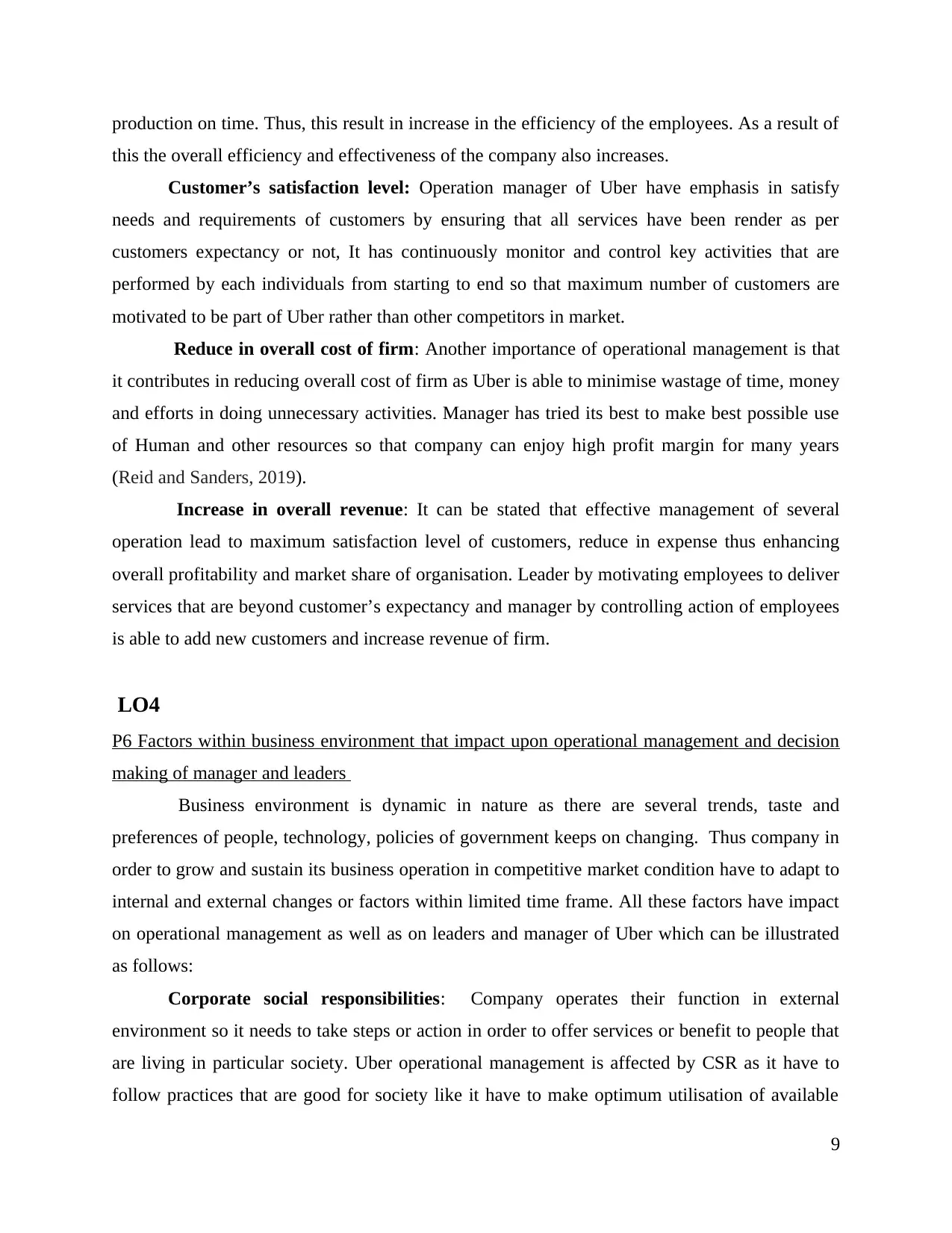
production on time. Thus, this result in increase in the efficiency of the employees. As a result of
this the overall efficiency and effectiveness of the company also increases.
Customer’s satisfaction level: Operation manager of Uber have emphasis in satisfy
needs and requirements of customers by ensuring that all services have been render as per
customers expectancy or not, It has continuously monitor and control key activities that are
performed by each individuals from starting to end so that maximum number of customers are
motivated to be part of Uber rather than other competitors in market.
Reduce in overall cost of firm: Another importance of operational management is that
it contributes in reducing overall cost of firm as Uber is able to minimise wastage of time, money
and efforts in doing unnecessary activities. Manager has tried its best to make best possible use
of Human and other resources so that company can enjoy high profit margin for many years
(Reid and Sanders, 2019).
Increase in overall revenue: It can be stated that effective management of several
operation lead to maximum satisfaction level of customers, reduce in expense thus enhancing
overall profitability and market share of organisation. Leader by motivating employees to deliver
services that are beyond customer’s expectancy and manager by controlling action of employees
is able to add new customers and increase revenue of firm.
LO4
P6 Factors within business environment that impact upon operational management and decision
making of manager and leaders
Business environment is dynamic in nature as there are several trends, taste and
preferences of people, technology, policies of government keeps on changing. Thus company in
order to grow and sustain its business operation in competitive market condition have to adapt to
internal and external changes or factors within limited time frame. All these factors have impact
on operational management as well as on leaders and manager of Uber which can be illustrated
as follows:
Corporate social responsibilities: Company operates their function in external
environment so it needs to take steps or action in order to offer services or benefit to people that
are living in particular society. Uber operational management is affected by CSR as it have to
follow practices that are good for society like it have to make optimum utilisation of available
9
this the overall efficiency and effectiveness of the company also increases.
Customer’s satisfaction level: Operation manager of Uber have emphasis in satisfy
needs and requirements of customers by ensuring that all services have been render as per
customers expectancy or not, It has continuously monitor and control key activities that are
performed by each individuals from starting to end so that maximum number of customers are
motivated to be part of Uber rather than other competitors in market.
Reduce in overall cost of firm: Another importance of operational management is that
it contributes in reducing overall cost of firm as Uber is able to minimise wastage of time, money
and efforts in doing unnecessary activities. Manager has tried its best to make best possible use
of Human and other resources so that company can enjoy high profit margin for many years
(Reid and Sanders, 2019).
Increase in overall revenue: It can be stated that effective management of several
operation lead to maximum satisfaction level of customers, reduce in expense thus enhancing
overall profitability and market share of organisation. Leader by motivating employees to deliver
services that are beyond customer’s expectancy and manager by controlling action of employees
is able to add new customers and increase revenue of firm.
LO4
P6 Factors within business environment that impact upon operational management and decision
making of manager and leaders
Business environment is dynamic in nature as there are several trends, taste and
preferences of people, technology, policies of government keeps on changing. Thus company in
order to grow and sustain its business operation in competitive market condition have to adapt to
internal and external changes or factors within limited time frame. All these factors have impact
on operational management as well as on leaders and manager of Uber which can be illustrated
as follows:
Corporate social responsibilities: Company operates their function in external
environment so it needs to take steps or action in order to offer services or benefit to people that
are living in particular society. Uber operational management is affected by CSR as it have to
follow practices that are good for society like it have to make optimum utilisation of available
9
⊘ This is a preview!⊘
Do you want full access?
Subscribe today to unlock all pages.

Trusted by 1+ million students worldwide
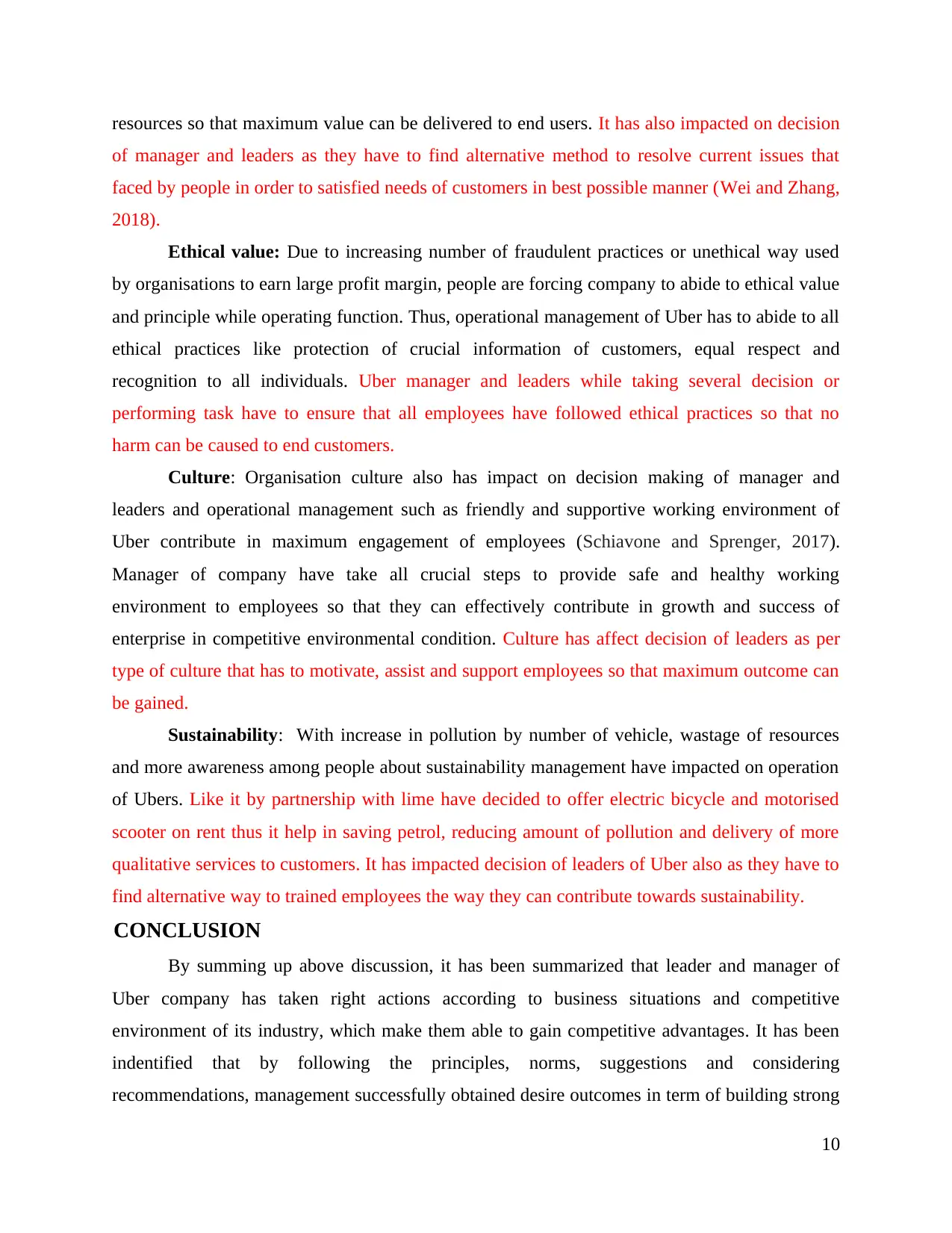
resources so that maximum value can be delivered to end users. It has also impacted on decision
of manager and leaders as they have to find alternative method to resolve current issues that
faced by people in order to satisfied needs of customers in best possible manner (Wei and Zhang,
2018).
Ethical value: Due to increasing number of fraudulent practices or unethical way used
by organisations to earn large profit margin, people are forcing company to abide to ethical value
and principle while operating function. Thus, operational management of Uber has to abide to all
ethical practices like protection of crucial information of customers, equal respect and
recognition to all individuals. Uber manager and leaders while taking several decision or
performing task have to ensure that all employees have followed ethical practices so that no
harm can be caused to end customers.
Culture: Organisation culture also has impact on decision making of manager and
leaders and operational management such as friendly and supportive working environment of
Uber contribute in maximum engagement of employees (Schiavone and Sprenger, 2017).
Manager of company have take all crucial steps to provide safe and healthy working
environment to employees so that they can effectively contribute in growth and success of
enterprise in competitive environmental condition. Culture has affect decision of leaders as per
type of culture that has to motivate, assist and support employees so that maximum outcome can
be gained.
Sustainability: With increase in pollution by number of vehicle, wastage of resources
and more awareness among people about sustainability management have impacted on operation
of Ubers. Like it by partnership with lime have decided to offer electric bicycle and motorised
scooter on rent thus it help in saving petrol, reducing amount of pollution and delivery of more
qualitative services to customers. It has impacted decision of leaders of Uber also as they have to
find alternative way to trained employees the way they can contribute towards sustainability.
CONCLUSION
By summing up above discussion, it has been summarized that leader and manager of
Uber company has taken right actions according to business situations and competitive
environment of its industry, which make them able to gain competitive advantages. It has been
indentified that by following the principles, norms, suggestions and considering
recommendations, management successfully obtained desire outcomes in term of building strong
10
of manager and leaders as they have to find alternative method to resolve current issues that
faced by people in order to satisfied needs of customers in best possible manner (Wei and Zhang,
2018).
Ethical value: Due to increasing number of fraudulent practices or unethical way used
by organisations to earn large profit margin, people are forcing company to abide to ethical value
and principle while operating function. Thus, operational management of Uber has to abide to all
ethical practices like protection of crucial information of customers, equal respect and
recognition to all individuals. Uber manager and leaders while taking several decision or
performing task have to ensure that all employees have followed ethical practices so that no
harm can be caused to end customers.
Culture: Organisation culture also has impact on decision making of manager and
leaders and operational management such as friendly and supportive working environment of
Uber contribute in maximum engagement of employees (Schiavone and Sprenger, 2017).
Manager of company have take all crucial steps to provide safe and healthy working
environment to employees so that they can effectively contribute in growth and success of
enterprise in competitive environmental condition. Culture has affect decision of leaders as per
type of culture that has to motivate, assist and support employees so that maximum outcome can
be gained.
Sustainability: With increase in pollution by number of vehicle, wastage of resources
and more awareness among people about sustainability management have impacted on operation
of Ubers. Like it by partnership with lime have decided to offer electric bicycle and motorised
scooter on rent thus it help in saving petrol, reducing amount of pollution and delivery of more
qualitative services to customers. It has impacted decision of leaders of Uber also as they have to
find alternative way to trained employees the way they can contribute towards sustainability.
CONCLUSION
By summing up above discussion, it has been summarized that leader and manager of
Uber company has taken right actions according to business situations and competitive
environment of its industry, which make them able to gain competitive advantages. It has been
indentified that by following the principles, norms, suggestions and considering
recommendations, management successfully obtained desire outcomes in term of building strong
10
Paraphrase This Document
Need a fresh take? Get an instant paraphrase of this document with our AI Paraphraser

workplace and developing positive workplace where people are highly motivated and has great
morale. Furthermore, by using total quality management and other operations management
approaches manager has played vital role as he or she increased productivity and sales level even
better by improving quality and service standards. Administration by using appropriate
framework and models determine those factors that has impact overall business and decision
making act of organization.
11
morale. Furthermore, by using total quality management and other operations management
approaches manager has played vital role as he or she increased productivity and sales level even
better by improving quality and service standards. Administration by using appropriate
framework and models determine those factors that has impact overall business and decision
making act of organization.
11

REFERENCES
Book and journals
Abbas, J., 2020. Impact of total quality management on corporate green performance through the
mediating role of corporate social responsibility. Journal of Cleaner Production. 242.
p.118458.
Barnes, D., 2018. Operations Management. Macmillan International Higher Education.
Dawson, S and et.al., 2018, March. Rethinking learning analytics adoption through complexity
leadership theory. In Proceedings of the 8th International Conference on Learning Analytics
and Knowledge (pp. 236-244).
Imran, M. and et.al., 2018. The mediating role of total quality management between
entrepreneurial orientation and SMEs export performance. Management Science
Letters. 8. pp.519-532.
Matthias, O and et.al., 2017. Making sense of Big Data–can it transform operations
management?. International Journal of Operations & Production Management.
Mitra, S. and Karathanasopoulos, A., 2019. Firm Value and the Impact of Operational
Management. Asia-Pacific Financial Markets. 26(1). pp.61-85.
Reid, R. D. and Sanders, N. R., 2019. Operations management: an integrated approach. John
Wiley & Sons.
Ren, H. and Huang, T., 2018. Modeling customer bounded rationality in operations management:
A review and research opportunities. Computers & Operations Research, 91. pp.48-58.
Schiavone, F. and Sprenger, S., 2017. Operations management and digital technologies.
Walls, E., 2019. The value of situational leadership. Community practitioner: the journal of the
Community Practitioners'& Health Visitors' Association. 92(2). pp.31-33.
Wamba, S. F and et.al., 2018. Big data analytics in operations and supply chain
management. Annals of Operations Research, 270(1-2). pp.1-4.
Wei, M. M. and Zhang, F., 2018. Recent research developments of strategic consumer behavior
in operations management. Computers & Operations Research, 93. pp.166-176.
12
Book and journals
Abbas, J., 2020. Impact of total quality management on corporate green performance through the
mediating role of corporate social responsibility. Journal of Cleaner Production. 242.
p.118458.
Barnes, D., 2018. Operations Management. Macmillan International Higher Education.
Dawson, S and et.al., 2018, March. Rethinking learning analytics adoption through complexity
leadership theory. In Proceedings of the 8th International Conference on Learning Analytics
and Knowledge (pp. 236-244).
Imran, M. and et.al., 2018. The mediating role of total quality management between
entrepreneurial orientation and SMEs export performance. Management Science
Letters. 8. pp.519-532.
Matthias, O and et.al., 2017. Making sense of Big Data–can it transform operations
management?. International Journal of Operations & Production Management.
Mitra, S. and Karathanasopoulos, A., 2019. Firm Value and the Impact of Operational
Management. Asia-Pacific Financial Markets. 26(1). pp.61-85.
Reid, R. D. and Sanders, N. R., 2019. Operations management: an integrated approach. John
Wiley & Sons.
Ren, H. and Huang, T., 2018. Modeling customer bounded rationality in operations management:
A review and research opportunities. Computers & Operations Research, 91. pp.48-58.
Schiavone, F. and Sprenger, S., 2017. Operations management and digital technologies.
Walls, E., 2019. The value of situational leadership. Community practitioner: the journal of the
Community Practitioners'& Health Visitors' Association. 92(2). pp.31-33.
Wamba, S. F and et.al., 2018. Big data analytics in operations and supply chain
management. Annals of Operations Research, 270(1-2). pp.1-4.
Wei, M. M. and Zhang, F., 2018. Recent research developments of strategic consumer behavior
in operations management. Computers & Operations Research, 93. pp.166-176.
12
⊘ This is a preview!⊘
Do you want full access?
Subscribe today to unlock all pages.

Trusted by 1+ million students worldwide
1 out of 12
Related Documents
Your All-in-One AI-Powered Toolkit for Academic Success.
+13062052269
info@desklib.com
Available 24*7 on WhatsApp / Email
![[object Object]](/_next/static/media/star-bottom.7253800d.svg)
Unlock your academic potential
Copyright © 2020–2025 A2Z Services. All Rights Reserved. Developed and managed by ZUCOL.





